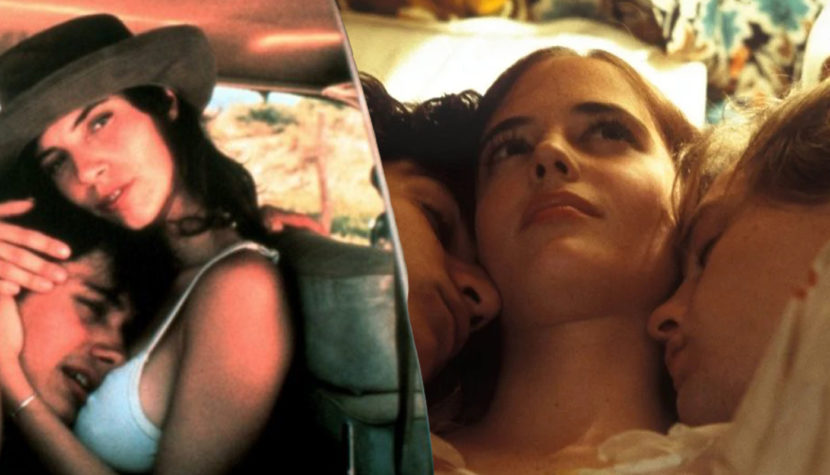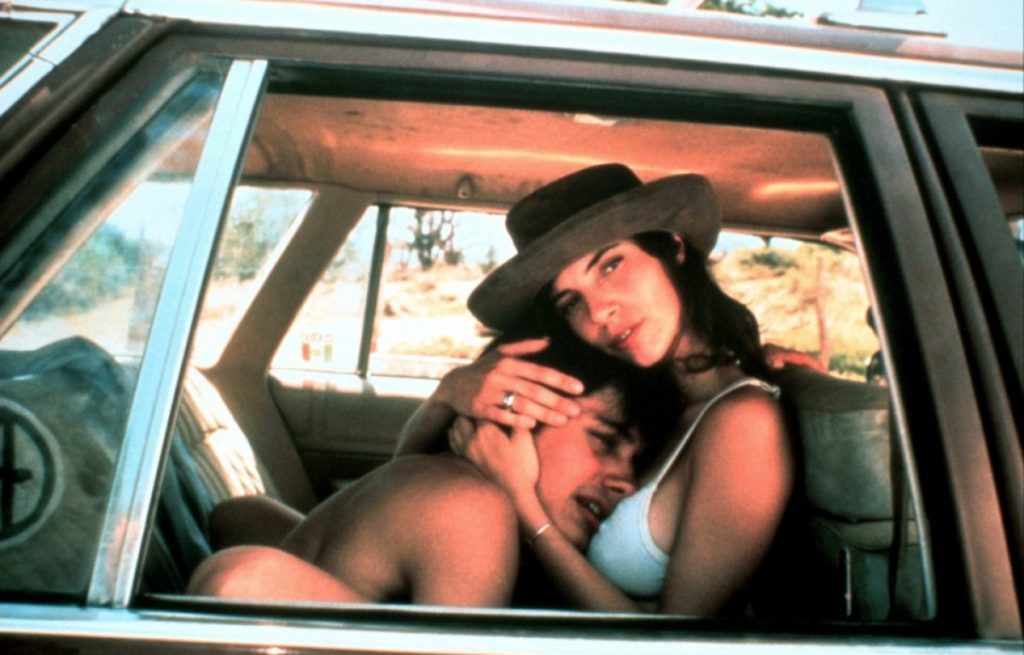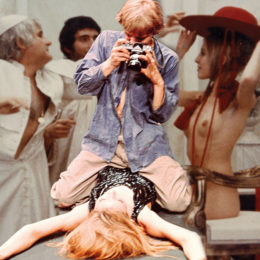Nudity, frivolity, perversion. Movies that BROKE SEXUAL TABOOS

With the advent of photography came erotic photography. Postcards with naked men and women were extremely popular in the 19th century. So it should come as no surprise that with the advent of the first cameras, nudity, sex and frivolity began to make their way into the film. And it’s not about old porn movies either. So it’s not surprising that most of the films that broke sexual taboos are works from the early days of cinematography. But not only.
Female nudity
The Czech film Extase from 1933 was one of the first films that caused a sensation because of the depiction of female nudity. 18-year-old Austrian actress Hedy Lamarr appeared on the screen, running naked through the trees and jumping into the river. But this is not the only obscenity that the director of the work, Gustav Machatý, decided to do. Film beauty, Eva, leaves her impotent husband and starts a hot romance with a newly met, younger man. Then we witness one of the first scenes of sex and female orgasm in the movies, not counting, of course, pornographic films produced at that time.

Or maybe it’s not the scenes of full nudity, but scenes that suggest nudity that are most arousing? In the 1931 film, A Free Soul, Norma Shearer wears a close-fitting white satin dress that is sheer and subtly betrays her lack of underwear. Similarly, Jean Harlow, who in Red Dust bares her naked breasts to Clark Gable, bathing in a barrel filled with rainwater. From the mid-1930s, only anthropological documentaries about indigenous peoples could smuggle nudity and not arouse the suspicions of strict censors. All thanks to the Hayes Code.
The above nudity, however, mostly describes topless women. But nudity from the waist down was much more illegal. Officially, Francesco Goya’s Maja naked from 1800 is considered the first depiction of female pubic hair in a painting. The first glimpse of female pubic hair in a film did not take place until 1966. Michelangelo Antonioni’s famous movie Blow-up then became a symbol of the official fall of Hollywood’s censorship in 1968.
Male nudity
The famous lover Clark Gable accompanied on the set actresses who went down in the history of cinema as seductresses showing their nakedness in front of the camera. The actor himself was also making history, but the history of male nudity on the screen. Female nudity began with brief flashes of fair skin or close-ups of naked legs. Men’s from unbuttoned shirts. The most memorable one was taken on the set of It Happened One Night in 1934. There is a famous sequence in which Gable nonchalantly unbuttons his shirt in the company of his on-screen companion, Claudette Colbert. Reportedly, when an actor unbuttoned his shirt to reveal his bare, glowing torso, sales of men’s T-shirts in America dropped by 40%.
Today we can laugh at viewers embarrassed by bare torsos in movies. We are in the 21st century, but full frontal male nudity is still rare. The 1969 film Women in Love turned out to be a breakthrough film in this field. However, we are talking about a film intended for a wider audience here. The most famous scene, for several reasons, is the wrestling match between Oliver Reed and Alan Bates. Two muscular, heavily haired men strip naked to spar in the warm light of the fireplace, which further intensifies the impression of intimacy. The scene is clearly carnal and stuffy, seething with testosterone, no wonder it is considered the first nude scene in the history of homoerotic cinema. You can read more about male nudity on screen here. Below is a scene from the movie Women in Love:
Kissing
Movie kisses were not a big sensation at all. They have accompanied the cinema practically from the very beginning. It is enough to mention the film from 1896. The Kiss, because that is its title, also became the first kiss immortalized on film. The heroes are May Irwin and John Rice, who give each other kisses, not caring about the presence of the camera. So kissing was allowed from the beginning. Almost, because in the years of censorship, i.e. in the years 1930-50, after the introduction of the so-called Hays Code, anything even remotely obscene was severely restricted. Movies produced in those years were allowed to contain kisses, but they could only last 3 seconds. Kissing between two women or men was also forbidden.
The kiss itself might not have been so taboo. The people who kissed you, however, are a different matter altogether. The Hayes Code prohibited showing interracial relationships on screen. In the 1950s, however, more and more production began to break away from the rigid framework of constraints and prohibitions. The film Killer’s Kiss (1955), directed by Stanley Kubrick, is credited with being the first to show a kiss between a white woman and a black man. Irene Kane kisses Jamaican-born actor Frank Silver in it. The actor actually had a very fair skin tone, which is why probably a small part of the audience realized that it was actually an interracial kiss. The 1959 Crimson Kimono went a bit further. There is a passionate kiss between Japanese-American James Shigeta and Victoria Shaw. Racial differences could no longer be camouflaged so easily.

First sex scenes
I have already mentioned the first sexual intercourse shown on the screen in Gustav Machatý’s film Extase. What about the first non-pretend, completely realistic sex scene? The 1966 Danish drama Gift is credited with being the first film in which actors engage in an unsimulated sex act. However, key erotic scenes of Knud Leif Thomsen’s work were censored. The most explicit cinematic example of unsimulated sex on the screen is still Nagisa Ôshima’s famous Empire of the Senses from 1975. You can read more about the first sex scenes on the screen here.
Homosexuality
As for the first lesbian contacts on the screen, we should start with the goddess that was Marlene Dietrich. Her acting was often associated with a typically masculine appearance, wearing suits, slicking her hair back, and generally looking more like a man. In the 1930 film Morocco, the actress, clad in a men’s tuxedo, is unmistakably kissing an embarrassed woman sitting at a table with a woman and two men. Here is a scene from the movie:
A well-known and interesting motif penetrating lesbian themes is vampire cinema. There are at least a few examples of works in which female vampires realize their female desire. One of the most famous examples is The Hunger from 1983 and the romance of Catherine Deneuve and Susan Sarandon depicted in it. There, too, lesbian identity is emphasized by frequent disguises or resemblance to men, at least on one side.
Indirectly, the taboo related to showing sex between men was broken in 1919 in the film Anders als die Andern. Two men meet at a gay dance. Later in the apartment, one of them touches the other’s covered torso. Nothing, but the impact was quite large for those times. The innueando was important. However, gay cinema has stripped itself of the innocence of sweet kisses, and a good example of this is Jean Genet’s 1950’s Song of Love. The main characters, two convicts, spend their days together fantasizing and sharing cigarette smoke through a straw in a hole in the wall. As if that wasn’t enough, a prison guard gets immoral pleasure from spying on men masturbating in their cells. However, the first fully romantic kiss between two men in a movie can be considered Sunday Bloody Sunday in 1971 and the close-up of Murray Head and Peter Finch.

Anyway, full graphic nudity, penises exposed to the light of the camera, do not have to be the only elements that break the taboo. The cinema knows excerpts from the popular 1994 film Interview with the Vampire, where Antonio Banderas almost touches Brad Pitt with his lips. In some cases, the suggestion of a kiss can give you even stronger erotic thrills than graphic sex. Similarly, My Own Idaho from 1991, in which River Phoenix and Keanu Reeves ride a motorcycle. The physical closeness of men leaves behind a very strong erotic charge.
Sexual liberation on the screen. Menage à trois, orgies
The history of eroticism is not only undressing, kissing or sexual intercourse. The unbearable burden of the taboo rested not only on depicting non-heterosexual relationships, but also on any non-monogamous ones. A bold example is the 1933 film Design of Living. The liberated Gilda, played by Miriam Hopkins, meets two friends, Tom Chambers and George Curtis, on a train. Both men feel attracted to the woman, a and vice versa. While they initially agree to be platonic friends for the three of them, it doesn’t last long and a love triangle begins to boil. Finally, Gilda leaves her dull marriage behind and decides to live an exciting, polyamorous life in Paris with her two lovers.

In more recent films, ménage à trois focuses mainly on breaking barriers and sexual liberation of the characters. The breakthrough picture was The Dreamers from 2003. Matthew meets siblings Isabelle and Theo. At first he sleeps with the woman alone, but later on he also becomes close to Theo. Sex with a stranger, threesome, voyeurism, homosexual acts. The heroes together indulge in bed experiments.
Another well-known and non-pornographic film dealing with the issue of three-way love is And Your Mother Too. The film aroused much controversy. It touches on the subject of reaching sexual maturity, but also on the romance of young boys with an older, experienced woman.
Movies were equally eager to break the taboo of intergenerational romance. Just mention The Graduate, Lolita or American Beauty. The film Kids from 1995, on the other hand, breaks the taboo and talks about the promiscuity of American street teenagers. The film featured extremely young actors, which was unheard of at the time, and the sexual intercourse scene is played by a 17-year-old with a 13-year-old. The image aroused great controversy, and by some it was called child pornography. Today, however, Kids is a cult film of the 90s.

But back to Alfonso Cuarón’s film, Tenoch and Julio learn from Luisa how to deal with women. However, there is a rivalry between the heroes, although they end up in a hotel room anyway, kissing and having oral sex.
References to orgies can be found in the 1927 film Casanova, where the famous lover hosts several beautiful women in his bed. The film Caligula from 1978 is already a festival of debauchery as well as lust for power. The camera captures sexual intercourse carried out in various combinations. As many as 50 naked women took part in the key image of the orgy. Caligula went down in history as one of the most perverse movies in history. In Walerian Borowczyk’s 1973 film Immoral Tales, the film’s Elżbieta Batory organizes a vampire lesbian orgy in her chamber. Later, he bathes in the blood of slain virgins. It is not difficult to guess that the films did not receive much applause, due to accusations of immorality. However, the orgy scenes in the film clearly show that female desire is as strong as male desire.



